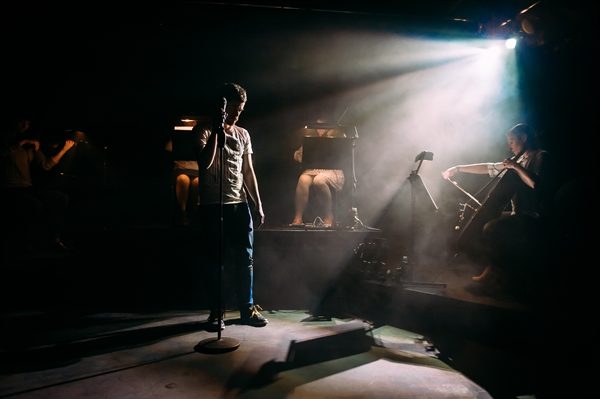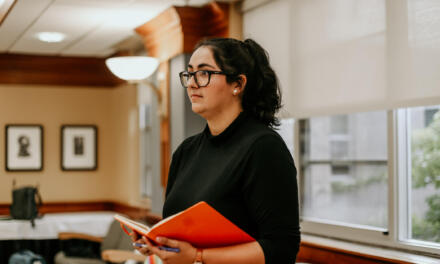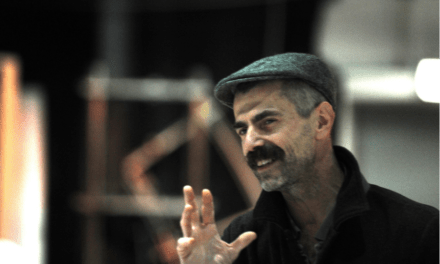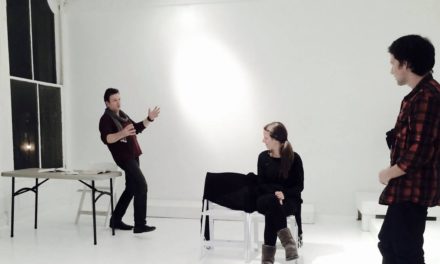Dosed up on caffeine on another rainy day in Glasgow. Ideal conditions to talk about dramaturgy with Michael John O’Neill, Associate Producer at Tron Theatre.
This is the only use I’ve found for a book called German Tetralogy…
…as a rest for a microphone
[German Tertalogy eventually found its way back to the University of Glasgow library, where I’m sure it will lie dormant until the end of time]
I really wanted to talk to you about Outside Eyes, can you tell me a little bit more about the idea, and where the motivation for creating the night came from?
Outside Eyes is a scratch night that follows a very similar model to scratch nights that have been going on all over the country, for years and years.
At a scratch night, the idea is to give a platform for works-in-progress to be exposed to that vital component of any live art – an audience. To see what works, how it feels for them, if there is anything specific that the audience latch onto. Then maybe ignore all that, or change one or two things.
I wanted to do Outside Eyes, a scratch night here at the Tron Theatre, because I love them. I love going along and seeing if I can get excited about what might be on stages in the future. I was a regular attendee to the Arches Scratch and one of my first professional gigs was as an intern at the Arches, they ran a sort of rolling internship
<– I meant to do air quotes there but no one can see that!
I’ll put them in later –> “ ”
The internship was really intense. I was there during one of the Arches LIVE festivals and one of my roles as an intern was to look after a scratch night. It was a really exciting process but also quite a frustrating one, especially when typing up the feedback from the audience to give to the artists, because the idea that this evening was a place for response felt almost like an after-thought. You can end up cramming a lot of artists into a very quick turn-around. It was difficult to get the audience to respond critically in those conditions. In the feedback we got, there were so many catty pointless things, and I was not in a position to give advice to the audience about what kind of feedback is most helpful.
So it always struck me that I wanted to see scratch nights with a bit more cushioning around them, a bit more emphasis on that side of it. Giving artists not just the opportunity to perform but giving audiences the opportunity to interact with their work.
Also, I really love structured response processes. There are a whole bunch of different ways of doing it, either a written feedback process or a facilitated discursive feedback process, but the important through-line of them all is the structure; having something to contain and guide the feedback.
Avoiding that post-show discussion free-for-all?
Post-show discussions can very quickly become dominated by a specific viewpoint, following a very specific idea of what that audience member likes and how the show could be more like what they like. It stops responding to what the artist puts forward, and becomes about what the responder wants to see in the world.
I wanted to put together a scratch night that was very focused and streamlined, giving time and weight and focus on the important role that the audience have when they get there. I made small tweaks to the format I usually encounter, giving the audience a bit more time, giving a fuller chat when they get there about what feedback means, and also – quite fascistically! – stopping the artists from being their own worst enemies with the questions they are asking. That was another thing I had found in previous processes, you ask the artists to write up questions and some of the real howlers you get are questions with yes/no answers. Which are almost always completely useless, what are you going to do, aggregate that? No, that’s not going to be useful for all. So at Outside Eyes we try to guide the artist so that they ask three questions that are really focused on prompting a fuller response, a poke to really think about what they’ve just seen.
That’s what Outside Eyes is supposed to be. The scratch that we’ve all been to see that then gives more time and consideration to the audience, making sure that their presence is a functional role in the process.
And it is not a show. It is not an end point. You’re having a fundamentally different relationship to the audience.
Absolutely. I know because I’ve taken part in scratch nights with my own work, when you’re making the work you just want to get it in front of people – and that can really tunnel vision you. You forget that there is something valuable beyond just getting it on for fifteen minutes, that you’ll lose if you don’t take the time to think about how that audience interaction can be as good, as fruitful, as it possibly can be.
So do you hand out surveys?
We hand out surveys as they go in. They get a bit of context about each of the shows. Then they are usually asked three questions, prompting a broad qualitative response, asking how it made them feel, trying to pose a question that opens the audience member up rather than shuts them down. Also after each piece, there is time given, that is not just to cover re-setting the stage, where we reiterate the purpose of the night and encourage people to think, remind them that it is an anonymous process and also that their feedback is important; that what they say could have a huge impact.
And the audience you get at Outside Eyes are very much invested in supporting the work, perhaps making it a very different audience to those who might see a more finished show?
A very different audience. We’re not pitching it at broad audiences at all. With any audience you are asking them to give up time and cash, time they could spend watching something more satisfying on Netflix! You’re asking them to jeopardize an hour of their lives; they might hate every single thing that they see.
So, broadly, the audience is people who work in the arts. I certainly see it as my role in managing the event to try and reach out to artists I know, companies I know, and get them to attend. To create a balance between people who really know their stuff and those who were just a bit more curious, or are there because their friend has some work on and they will just absolutely slate all the other ones!
We are making sure we are curating the audience a bit, getting a good mix.
You mention curation. Do you identify your role with Outside Eyes as being dramaturgical? You curate the work, to an extent, and place an emphasis on facilitating audience feedback. I was in a workshop with Lisa Nicoll (Development Producer at Tron) and when she explained her role I found a lot of overlap between the dramaturg and the producer. What is your opinion on that overlap, specifically in terms of your role in Outside Eyes?
I see my role largely as project management. I suppose if there is any distinct dramaturgical component to what I’m doing it is talking about the point of contact with the audience, rather than the piece itself. I really am very reticent in any project I’m working on, whether it is in Outside Eyes or something that is touring, to come in and force my perspective. I see my role as facilitating an environment where the individual artist feels freest to make the work they want to make.
I was talking to one of my friends last night, who is also a producer, and we feel that one of our main roles is to take the stress away from the artist, so they can focus on doing what they’re making, not the barrage of other incidental things that surround putting on a production.
We’re just stress-gluttons, that’s what we do.
“give me your stress, we’ll swallow it hole!”
There are productions where you will have a dramaturg, but that’s a luxury a lot of the time. Also, dramaturgical support, for a lot of artists at this level, is a bitty and diverse thing – it is not just one person coming in. It is about leaning on the people you trust. I genuinely believe everybody could be a creative guide to a project, as long as they are paired with the right person. There was a great interview with Louis CK; he was talking very specifically about the people he trusts to share his work with and it more resembles a network of dramaturgy, rather than one person.
As someone trained in ‘dramaturgy’ I wonder to what extent the word ‘dramaturg’ is profoundly unhelpful. The roles you’re describing, and these broad ideas of assistance and facilitation, resonate very strongly with the work that I do. Yet in my instance, the job title seems to get in the way, the label is off-putting.
It is one of the most loaded terms that I’ve come across. It has an edgy energy. To say you are a dramaturg you have to build up your courage first, because it is not as familiar a word, or role, as others involved in a creative process. If someone says they are a production manager, a technician, an actor, you can get a concrete sense of what that role involves, even though a lot of those roles are still very fluid. With dramaturg, a lot of people don’t make that initial leap to something concrete, broadly speaking. And it has that same fluidity of meaning too.
Ultimately I find the question of accountability important, and it proves useful for fleshing out these distinctions between roles, and within roles. Who are you accountable to within the work? Within Outside Eyes, where do you feel your accountability lies? To the Tron Theatre, to the artist, or to the work? Or is it all three?
In terms of Outside Eyes I most directly care about the artists. The most important thing about getting the audience in is to provide the best result for the artist, to make sure there are enough people in the room and they are getting something out of the process.
I feel accountable to the Tron because I want its artistic development output to keep going, for them to feel comfortable that they can still run these sort of things when I’m not here. And I want artists interacting with the Tron to feel like there is a way in. It is important to me that I talk about the successes of these things – Greater Belfast and How To Sing It were both at Outside Eyes last year, and that was the first step towards getting them where they are now – being performed in front of audiences in a professional context.
[Isobel McArthur’s How To Sing It was performed at Tron Theatre in June 2016 and Greater Belfast, written by Matt Regan, was performed at the Traverse Theatre at the 2016 Edinburgh Festival Fringe]
These are the kinds of story we need to proclaim loudly.
It is what The Arches used to offer quite distinctly. This was pointed out very well by Kieran Hurley at a post-Arches sort of meet-up. He described looking at The Arches, from the position of an emerging artist, as a ladder, you could move up. You could look at it, and know that there was a way to get your ideas moving forward. Making things without the structure of a producing company is hard work and exhausting. To go from step to step to step takes a long time, and your enthusiasm for the project is always in danger of running out.
I was looking at the Fringe guide whilst I was waiting. There are so many shows on, and I’ve made shows in that way, that are entirely self-sustaining. There is a pleasure in making work that way, a genuine excitement, but you’re right that it isn’t sustainable in the long term; it is exhausting. As an artist you do need that support, to have people who are willing to invest their time in your work, to give you a hand.
Exactly. As much as we talk about the fiscal component of making your own work, the other aspect that you pour lots of into the mix is your energy, your drive. Going to the Fringe, and doing your show for a max of fifteen people over a three week run, you get to the end and you can’t be arsed doing another show. So that’s why it is important to have things out there that offer a way to move forward. Visibility is key.
I was at the Royal Conservatoire of Scotland’s On the Verge, and following the closure of the Arches it is now upstairs in Sloan’s Bar, which is a huge shift. But I think, programmes like Outside Eyes and its recent successes mean that you can now create a pathway from the upstairs of a bar to this theatre. That feels hugely important, and there is nowhere else in Glasgow where that path is as clear at the moment.
That’s good to hear. We need to maintain it. If you think about the people who have come from Glasgow, people like Gary McNair, Kieran Hurley and Nic Green, who were making work no one would have necessarily been aware of and now they are international touring artists, and that’s because there were resources available – and people – to spend time on their work. To give them opportunities to get up there and mess it up, and then come back and try it again. It is very important.
With the Arches going under it has been really interesting to see the response. Lots of venues in Glasgow have responded by trying to open it up. The Citizen’s Theatre is offering more space, and Tramway has developed its particular dance focus, supporting a lot of artists who would have come up through the Arches. Platform have been doing incredible work, they have really decent rehearsal spaces and such a strong connection to the Easterhouse community, and keep that alive in the projects they support.
Also rough DIY things have popped up – such as Only Skin running their stuff. There are things popping up all over the place.
That’s the wonderful thing about any calamity – the response. Out of the tragedy there’s a necessity to create new things. We’re in a really exciting state of flux. How do we respond to this seismic change in the landscape?
My take on things that have been happening in Tron. Post-Arches a culture of development has been coming into the building, with the Labs, Tron 100, Outside Eyes. Broadly speaking I’ve seen it to reflect a much wider engagement with work at a dramaturgical level, do you see it in that way?
I’m in love with organizations like the TEAM, with the sheer amount of time they have to put things together; they spend years putting it together, literally years.
[they also performed Anything That Gives Off Light at the Edinburgh International Festival in August 2016]
Yet a lot of these projects look like shit on a page, they don’t look like scripts, you can’t measure or identify it in any solid way that can make an argument for the work until you actually see some of it happen. So there needs to be a broad openness and accessibility for artists so they can come in and make the argument for their work themselves, a small performance for a small crowd of producers or programmers, getting them in front people who can open doors for them. That’s one model of artistic development, and something like Tron 100 fits into that.
[Tron 100 is a year-long artistic membership initiative offering a programme of workshops, panels and masterclasses]
At the same time, you need a second strategy, a more curatorial approach. Something like Starter for 10 represents this, where you are taking something of a cash-gamble on a piece of work.
[For Starter for 10 the National Theatre of Scotland offered ten aspiring theatre-makers a funded residency of £2,500 to help them develop their skills, networks or explore a new idea for a piece of theatre]
And you need both of these to be happening at the same time, with a level of interaction in between. That’s how you create the ladder.
I can see why people might be critical of development culture, that there is stuff happening all time but does any of it ever get anywhere? Well obviously 90% – that’s a figure I just made up – 90% doesn’t, maybe because there isn’t room, exhaustion sets in, or the work is basically no good. That’s the reality.
Yet if we want to see new and exciting things we have to create an environment where people feel happy to try stuff out, where they feel supported and safe to try an idea that might fall flat on its face, and then they go “Right, onto the next one!” or “Rework this” or “I want to try a different version of what I wrote.” Sometimes in that process of development doors close, and you have to ask yourself “what else can I do?”
So it comes back to the artist to make sure they are not exhausting themselves from the culture of development. If there is a way that’s not working – and you really want to get your work out there – take a different tact. The sunk cost fallacy is one of the biggest dangers of working in a perpetual state of development. The idea that you’ve put in so much effort into a piece that you might as well just keep going.
You have to have an awareness of when you need to change what you’re doing.
Also, if 90% of work doesn’t ultimately make it through, then we’re all a part of that group and will at some stage make work that doesn’t get through
You have to accept that chaos or you’ll go mad. Sometimes you have to accept that it might just not be your turn. With How To Sing It the first year we applied for funding we didn’t get through, we had to try again the next. Had we really become more viable artists in that time? Or had something about that gatekeeping process changed? Or was it just the luck of the draw? Something about the way we phrased our argument just hit the spot that one time. There is a large chunk of this process, especially at the early stages of careers, which is just total luck.
There are two sides to the coin of the developmental culture, to the economy of theatre ideas. That there is a really strong craft to pick from is important – for the greater good there needs to be. Yet the other side is that if you are working in a role such as this, or running a scratch night, then you are committing to creating a culture where a lot of people will have to struggle in order to eventually not have your dreams realised.
Having honest conversations with artists is a big part of what I’ve been doing.
When I started I thought maybe one of the most useful things I could do was offer myself as a spare person, helping with funding applications, or feeding back on scripts. I wanted to be available to do those little bits and pieces, and a big part of that became about having honest conversations with artists about making work that fits into the world, and being at peace with the difficulties they would face. Talking through that, and trying to find ways of making it not-crushing, and to not make phantom enemies out of the gatekeepers – the people at Creative Scotland are people too!
This article was originally published on Talking Dramaturgy. Reposted with permission. Read the original article.
This post was written by the author in their personal capacity.The opinions expressed in this article are the author’s own and do not reflect the view of The Theatre Times, their staff or collaborators.
This post was written by Andrew Edwards.
The views expressed here belong to the author and do not necessarily reflect our views and opinions.


















